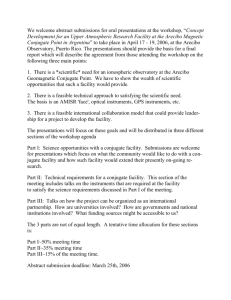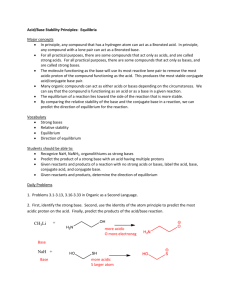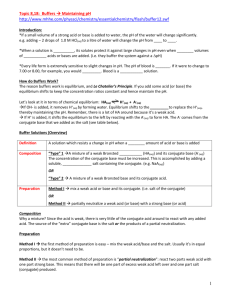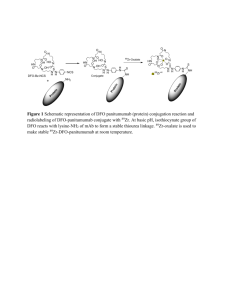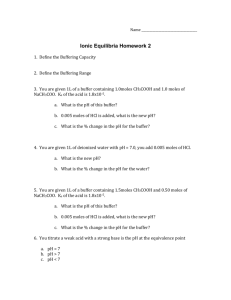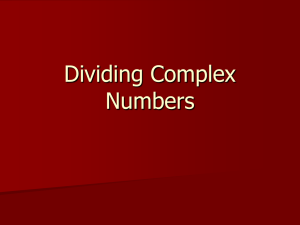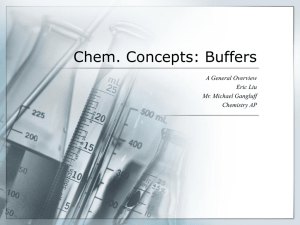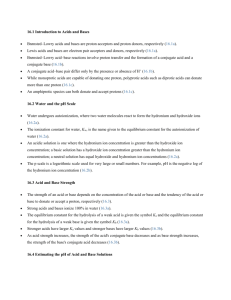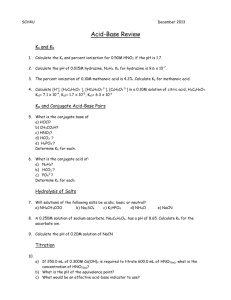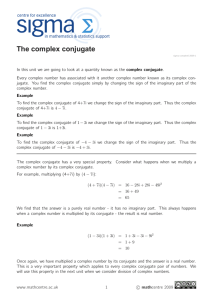Review WS Answers of Conceptual Qs
advertisement
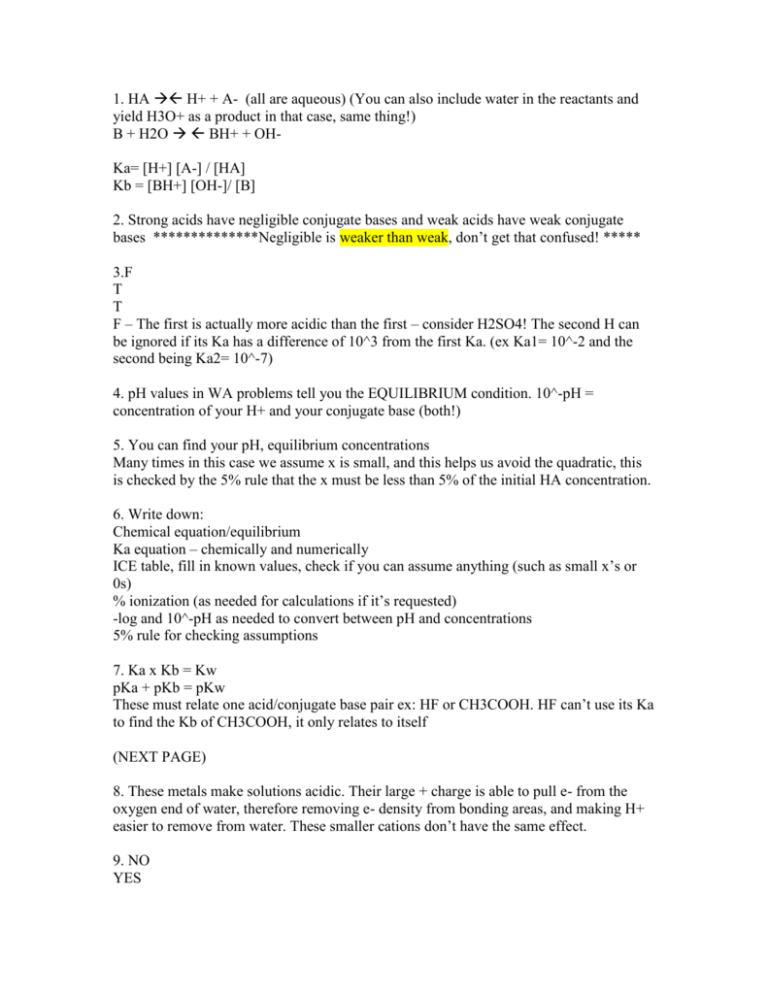
1. HA H+ + A- (all are aqueous) (You can also include water in the reactants and yield H3O+ as a product in that case, same thing!) B + H2O BH+ + OHKa= [H+] [A-] / [HA] Kb = [BH+] [OH-]/ [B] 2. Strong acids have negligible conjugate bases and weak acids have weak conjugate bases **************Negligible is weaker than weak, don’t get that confused! ***** 3.F T T F – The first is actually more acidic than the first – consider H2SO4! The second H can be ignored if its Ka has a difference of 10^3 from the first Ka. (ex Ka1= 10^-2 and the second being Ka2= 10^-7) 4. pH values in WA problems tell you the EQUILIBRIUM condition. 10^-pH = concentration of your H+ and your conjugate base (both!) 5. You can find your pH, equilibrium concentrations Many times in this case we assume x is small, and this helps us avoid the quadratic, this is checked by the 5% rule that the x must be less than 5% of the initial HA concentration. 6. Write down: Chemical equation/equilibrium Ka equation – chemically and numerically ICE table, fill in known values, check if you can assume anything (such as small x’s or 0s) % ionization (as needed for calculations if it’s requested) -log and 10^-pH as needed to convert between pH and concentrations 5% rule for checking assumptions 7. Ka x Kb = Kw pKa + pKb = pKw These must relate one acid/conjugate base pair ex: HF or CH3COOH. HF can’t use its Ka to find the Kb of CH3COOH, it only relates to itself (NEXT PAGE) 8. These metals make solutions acidic. Their large + charge is able to pull e- from the oxygen end of water, therefore removing e- density from bonding areas, and making H+ easier to remove from water. These smaller cations don’t have the same effect. 9. NO YES 10. ACID, NH3, ACIDIC 11. HX acid strength is predominantly affected by SIZE of X Oxyacids are affected by EN and #Os Carboxylic acids – RESONANCE, CONJUGATE BASE 12. Lewis acid – Electron pair acceptor Lewis base – electron pair donor (AMINES) 13. DECREASES, yes, follows le chatelier 14. The salt or strong electrolyte concentration ends up on the products side, generally as a conjugate base as in the case of weak acids. The pH in this case isn’t affected by the small salt ion contributed by the strong electrolyte (ex: Na+ or Cl-), just by the weak acid dissociation 15. (17.2) F (small swings observed) pH= pKa + log (A-/HA) 16. HCl interacts with the conjugate base (strong acid always will!) and NaOH interacts with the non-dissociated acid pH will swing slightly acidic with the addition of acid and will rise slightly with the addition of base – but not by much 17. The buffer with higher concentrations has a higher buffer capacity. Consider the addition of 1L of 1M NaOH in this case, which would you expect to handle that better? pH values of these will be the same though - - plug them into HH equation to see!! 18. “Before, aaddition, and After” tables are helpful in buffer probs 19. Draw your curve (see the book for help) SEE PAGE 718 FOR HELP ON THIS! Areas: 1. Before base is added, make a Ka problem, use an ICE table as needed, use –log of your found H+ concentration, and voila 2. This area is the flat part before the equivalence pt… some base has been added, and you must treat it as a BUFFER prob. Find the moles of all the species involved –( Acid, conjugate base) this is done by subtracting the moles of base from acid to give you your remaining acid moles, this same subtracted amount is the amount of conjugate base. (Your conjugate base and acid will have difference molar amounts though!) plug into your HH equation 3. equivalence point – Kb problem. FIRST – write out your new basic interaction with the conjugate base interacting with water and yielding OH and the original acid specie. Then write the chemical Kb equation, calculate your Kb using Kw and Ka. Plug in your concentration of conjugate base (denominator, divide by total volume!!) and then solve for x^2 on top. 4. The area after the equivalence point is a strong base problem. Subtract the moles of acid from moles of strong base, divide by NEW TOTAL VOLUME, take negative log, subtract from 14, and voila! This may be hard to understand. Look at your book, the blue boxed areas walk you through the entire process! SA/SB calculation has an equivalence pt of 7 WA/SB is basic at equiv, acidic in a WB, SA Indicators should have a pH range that falls around or near the equivalence point 17.4 SEE PAGE 724 FOR BOX DIAGRAM THAT EXPLAINS THIS!! 17.5 Decrease Increase Increase Q> Ksp precipitation occurs, too much in solution Q < Ksp precipitate would be take up into solution (dissolve more) Q=Ksp Equilibrium! Lower Ksp precipitate first! (You only have to know this conceptually)


